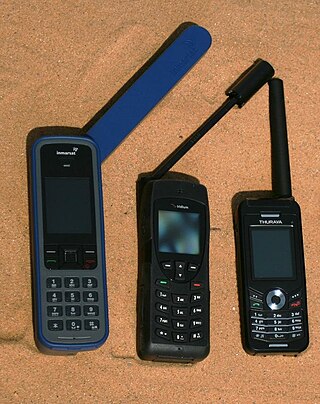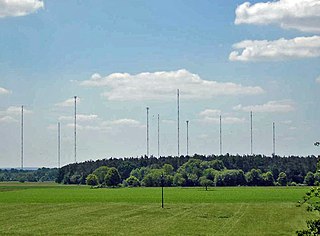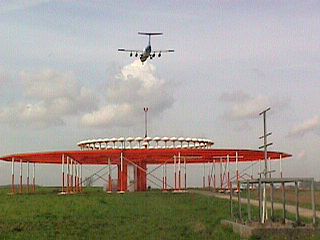
Frequency allocation is the part of spectrum management dealing with the designation and regulation of the electromagnetic spectrum into frequency bands, normally done by governments in most countries. Because radio propagation does not stop at national boundaries, governments have sought to harmonise the allocation of RF bands and their standardization.
The radio spectrum is the part of the electromagnetic spectrum with frequencies from 3 Hz to 3,000 GHz (3 THz). Electromagnetic waves in this frequency range, called radio waves, are widely used in modern technology, particularly in telecommunication. To prevent interference between different users, the generation and transmission of radio waves is strictly regulated by national laws, coordinated by an international body, the International Telecommunication Union (ITU).

As defined by FS-1037C and ITU Radio Regulations, radiodetermination is:
the determination of the position, velocity or other characteristics of an object, or the obtaining of information relating to these parameters, by means of the propagation properties of radio waves
Radiolocation, also known as radiolocating or radiopositioning, is the process of finding the location of something through the use of radio waves. It generally refers to passive uses, particularly radar—as well as detecting buried cables, water mains, and other public utilities. It is similar to radionavigation, but radiolocation usually refers to passively seeking a distant object rather than actively finding one's own position; both are types of radiodetermination. Radiolocation is also used in real-time locating systems (RTLS) for tracking valuable assets.

Fixed-satellite service is – according to article 1.21 of the International Telecommunication Union's (ITU) Radio Regulations (RR) – defined as A radiocommunication service between earth stations at given positions, when one or more satellites are used; the given position may be a specified fixed point or any fixed point within specified areas; in some cases this service includes satellite-to-satellite links, which may also be operated in the inter-satellite service; the fixed-satellite service may also include feeder links for other space radiocommunication services.

Spectrum management is the process of regulating the use of radio frequencies to promote efficient use and gain a net social benefit. The term radio spectrum typically refers to the full frequency range from 1 Hz to 3000 GHz that may be used for wireless communication. Increasing demand for services such as mobile telephones and many others has required changes in the philosophy of spectrum management. Demand for wireless broadband has soared due to technological innovation, such as 3G and 4G mobile services, and the rapid expansion of wireless internet services.

Mobile-satellite service is – according to Article 1.25 of the International Telecommunication Union's Radio Regulations – "A radiocommunication service

In telecommunications, a fixed service is a radiocommunication service between specified fixed points.

Space operation service is – according to Article 1.23 of the International Telecommunication Union's (ITU) Radio Regulations (RR) – defined as A radiocommunication service concerned exclusively with the operation of spacecraft, in particular space tracking, space telemetry and space telecommand. These functions will normally be provided within the service in which the space station is operating.

Standard frequency and time signal service is, according to Article 1.53 of the International Telecommunication Union's (ITU) Radio Regulations (RR), "A radiocommunication service for scientific, technical and other purposes, providing the transmission of specified frequencies, time signals, or both, of stated high precision, intended for general reception".

Space research service is – according to Article 1.55 of the International Telecommunication Union's (ITU) Radio Regulations (RR) – defined as «A radiocommunication service in which spacecraft or other objects in space are used for scientific or technological research purposes.»

Safety service is – according to Article 1.59 of the International Telecommunication Union's (ITU) Radio Regulations (RR) – defined as «A radiocommunication service used permanently or temporarily for the safeguarding of human life and property.»

Land mobile-satellite service is – according to Article 1.27 of the International Telecommunication Union's (ITU) Radio Regulations (RR) – defined as «A mobile-satellite service in which mobile earth stations are located on land.»
A maritime mobile service is a mobile service between coast stations and ship stations, or between ship stations, or between associated on-board communication stations. The service may also be used by survival craft stations and emergency position-indicating radiobeacon stations.

Maritime mobile-satellite service is – according to Article 1.29 of the International Telecommunication Union's Radio Regulations (RR) – "A mobile-satellite service in which mobile earth stations are located on board ships; survival craft stations and emergency position-indicating radiobeacon stations may also participate in this service", in addition to serving as navigation systems.

Aeronautical mobile service is a form of aviation communication conducted through radio. The ITU Radio Regulations divide AMS into communication used for civil air route flights (R) and off-route flights (OR). Aeronautical mobile (R) service is a so-called safety-of-life service, must be protected for interferences, and is an essential part of air traffic control. Communication occurs between radio stations onboard aircraft, termed aircraft stations, and terrestrial stations that are sometimes termed "aeronautical stations". Communication can also occur between aircraft. AMS is commonly used in air traffic control.

Port operations service is – according to Article 1.30 of the International Telecommunication Union's (ITU) Radio Regulations (RR) – defined as «A maritime mobile service in or near a port, between coast stations and ship stations, or between ship stations, in which messages are restricted to those relating to the operational handling, the movement and the safety of ships and, in emergency, to the safety of persons. Messages which are of a public correspondence nature shall be excluded from this service.»

Ship movement service is – according to Article 1.31 of the International Telecommunication Union's (ITU) Radio Regulations (RR) – defined as «A safety service in the maritime mobile service other than a port operations service, between coast stations and ship stations, or between ship stations, in which messages are restricted to those relating to the movement of ships. Messages which are of a public correspondence nature shall be excluded from this service.»

Broadcasting-satellite service is – according to Article 1.39 of the International Telecommunication Union's (ITU) Radio Regulations (RR) – defined as «A radiocommunication service in which signals transmitted or retransmitted by space stations are intended for direct reception by the general public. In the broadcasting-satellite service, the term “direct reception” shall encompass both individual reception and community reception.»

Satellite emergency position-indicating radiobeacon station is – according to article 1.94 of the International Telecommunication Union's (ITU) ITU Radio Regulations (RR) – defined as "An earth station in the mobile-satellite service the emissions of which are intended to facilitate search and rescue (SAR) operations."
















